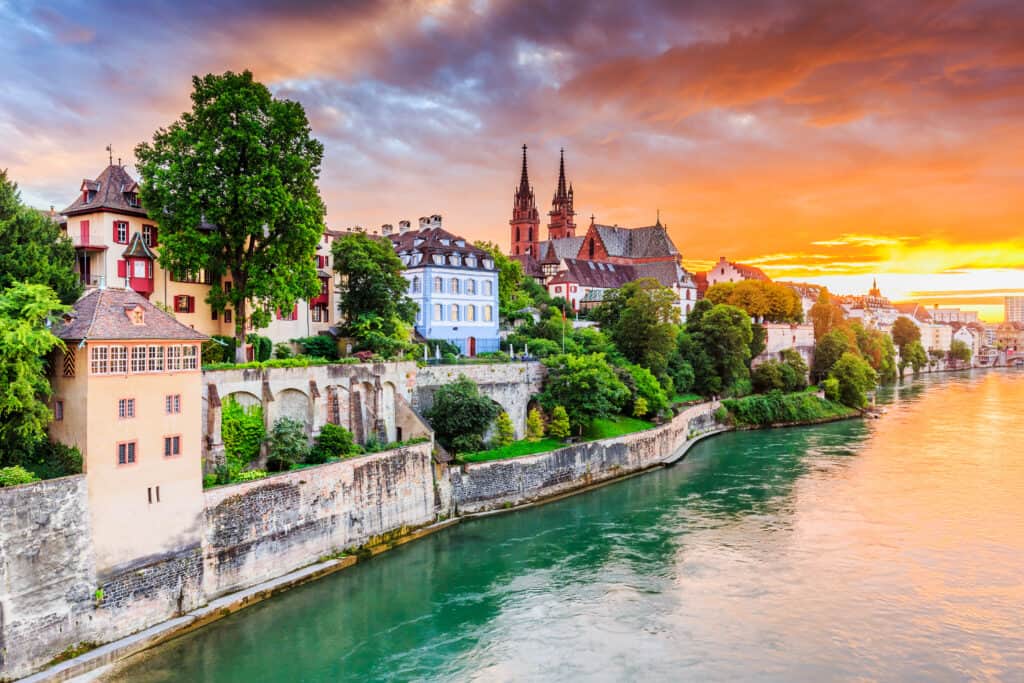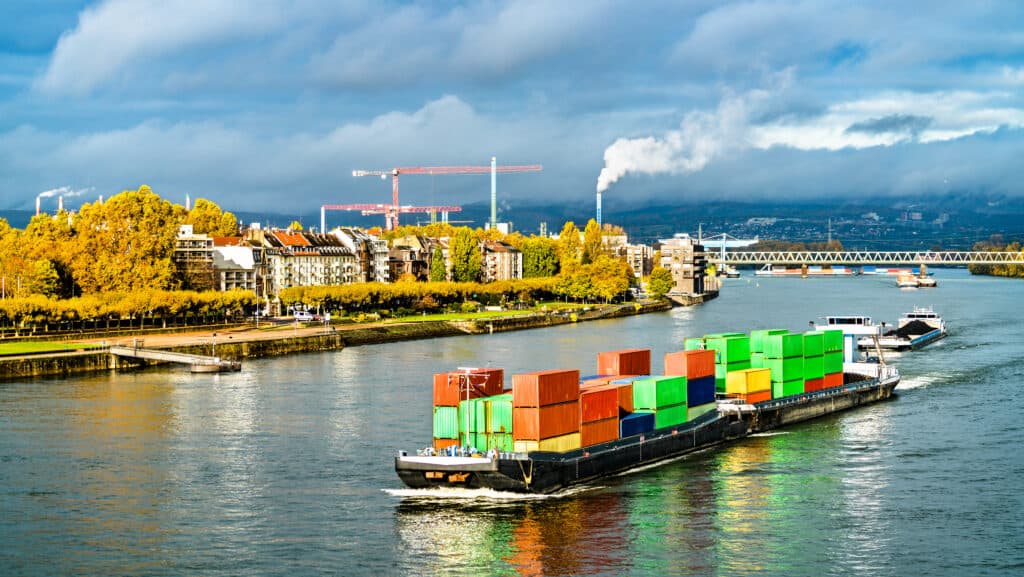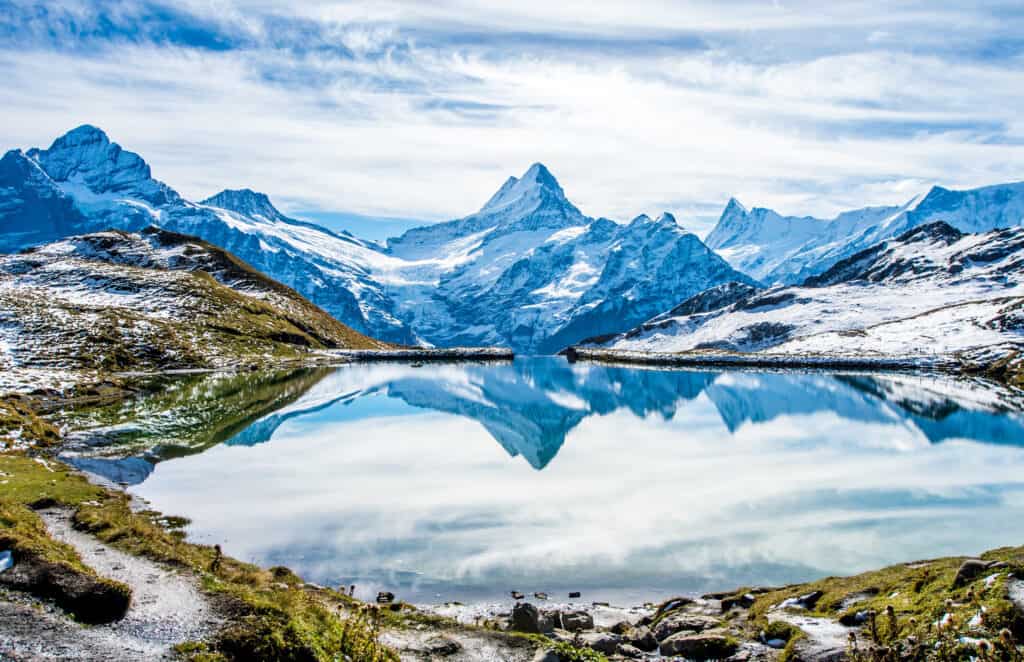This summer, much of Europe has seen sky-high temperatures and heat waves that have strained infrastructure. Along with immense heat comes an unprecedented drought and it’s starting to affect many of the rivers. The rivers of Europe are essential not only to local infrastructure and business but also to the global economy. Some historically important rivers, like the Rhine, will soon be impassable if conditions do not change very soon.
Where is the Rhine River?
The Rhine River stretches from the Swiss Alps to The North Sea. It starts in the canton of Grabünden and dumps out into the Atlantic Ocean over 700 miles away. The river defines several countries’ borders including the borders between Switzerland and Lichtenstein, Switzerland and Germany, Switzerland and Austria, and France and Germany. It flows through areas of those countries as well as the Netherlands. Several important cities lay on the river including Cologne, Dusseldorf, and Strasbourg.

Plunging water levels are causing shipping delays along the Rhine.
©SCStock/Shutterstock.com
Why Is the Rhine River Important?
People and businesses all along the Rhine River depend on the water for shipping and manufacturing. For example, some coal power plants and steel manufacturers in Germany rely on the river for the delivery of raw materials. At Kaub, an important passage on the river, the water level is so low that it is going to be impassable soon. This affects many industries, including manufacturing, utilities, and tourism.
The Impact of the Rhine River Drought
Prices of everything in the region will likely go up as a result of the drought. Shipping rates have skyrocketed because boats must take on less cargo due to the low water levels. And some areas may experience shortages of products. Prices for shipping down the Rhine have increased by as much as 30% in one day.
It will also affect already high energy prices. Germany’s coal plants have been helping to offset the reduction in gas coming from Russia. There were also plans to bring a few more back online. However, these shipping troubles could prevent or delay the needed energy boost. And already high energy prices may go up even more.
Residents in the area are already feeling the squeeze. Some people are stocking up on heating oil and diesel because they worry about shortages or high prices in the future. In the Netherlands, some ferries are not able to run. This affects daily commutes for everyone whether they drive, ride a bike, or walk to work. In France, over 100 communities have all but run out of water. They now rely on trucks to deliver water. In Germany, fields of Riesling (a type of white grape used to make Riesling wine) have turned brown, along with other agricultural products.
It’s not possible to simply replace cargo ships with train or truck transportation on a dime. More than 100 trucks would be required to carry the same amount of cargo that a river-ready cargo ship could carry. Germany already has a shortage of truck drivers and a congested train system. Plus, fuel prices for transportation are currently high, so switching to these methods wouldn’t reduce shipping costs much.
Tourism is also highly affected. River cruises down the Rhine are popular with tourists worldwide. With some areas of the river no longer safe, river cruises are now transporting would-be passengers by bus instead, with travelers often staying in hotels instead of on boats. Unsurprisingly, this has disappointed tourists. However, others were disappointed by a full cancellation: one river cruise company had to cancel 7% of its trips this year.

Water levels are so low due to the 2022 drought that some ships cannot sail even when empty.
©Leonid Andronov/Shutterstock.com
Why Is This Drought Happening?
Many experts believe this drought is a result of climate change. The important rivers of Europe get their water from glaciers in the Swiss Alps. In past spring and summer seasons, runoff from the glaciers along with rain made the rivers an abundant source of water. However, the glaciers are shrinking, and the area is a lot warmer, which affects evaporation levels.
Since 1850 the area has warmed 2 degrees. That might not seem like much, but in terms of the climate, that is a lot. The area underneath the glaciers is blank rock. Glaciers reflect the sunlight, keeping the area cooler. The rock absorbs it, retaining the heat and making the area warmer. So, as the glaciers melt, the area only continues its warming trend to the extreme. Due to this loop, scientists believe that the glaciers in the Swiss Alps will melt by the end of the 21st century.
Furthering the issue are changes to the jet stream. This important air current affects the weather worldwide. These changes are causing clear, dry, and cloudless weather to stall over Europe for weeks at a time.
However, experts also say that the high population of the Rhine region is also contributing to the problem and has been for a while. There are more than 50 million people living in the area, and they use the water for drinking, watching, agriculture, manufacturing, and more. Since the industrial revolution, the growing population has put more and more of a strain on the water supply.

Glaciers on the Swiss alps are shrinking due to climate change.
©Boris-B/Shutterstock.com
The Outlook for the Rhine River
Scientists are not very hopeful for the rivers that are currently drying up in Europe, including the Rhine. They believe the effects of climate change will only become more severe over the next few years and decades. While some projects are underway to make the Rhine River deeper, they won’t be completed until at least 2030. By that time, low water levels, fewer tourists, and inhibited shipping channels may have already affected many businesses beyond repair, depressing local economies.
The photo featured at the top of this post is © iStock.com/sborisov
Sources
- Bloomberg, Available here: https://www.bloomberg.com/news/features/2022-08-10/europe-s-low-water-levels-threaten-rhine-river-hit-80b-trade-lifeline
- Wikipedia, Available here: https://en.wikipedia.org/wiki/Rhine
- NY Times , Available here: https://www.nytimes.com/2022/08/29/travel/river-cruises-drought-europe.html
FAQs (Frequently Asked Questions)
Where is the Rhine River?
The Rhine River stretches from the Swiss Alps to The North Sea. It starts in the canton of grabünden and dumps out into the Atlantic Ocean over 700 miles away.
Why is the Rhine River important?
People and businesses all along The Rhine River depend on the water for shipping and manufacturing. For example, some coal power plants and steel manufacturers in Germany rely on the river for the delivery of raw materials.
What is the impact of drought on the Rhine River?
Prices of everything in the region will likely go up as a result of the drought and some areas may experience shortages of products. It may also raise already high energy prices. Tourism is also highly affected due to changes to itineraries or cancellations of River cruises down The Rhine that are popular with tourists worldwide.
Why is there a drought on the Rhine River?
Many experts believe this drought is a result of climate change. The important rivers of Europe get their water from glaciers in the Swiss Alps. The glaciers are shrinking. The area underneath the glaciers is blank rock. Glaciers reflect the sunlight, keeping the area cooler. The rock absorbs it, retaining the heat and making the area warmer. So, as the glaciers melt, the area only continues its warming trend to the extreme. Due to this loop, scientists believe that the glaciers in the Swiss Alps will be fully gone by the end of the 21st century.
Furthering the issue are changes to the jet stream. This important air current affects the weather worldwide. These changes are causing clear, dry, and cloudless weather to stall over Europe for weeks at a time.
The high population of the Rhine region is also contributing to the problem and has been for a while. There are more than 50 million people living in the area, and they use the water for drinking, watching, agriculture, manufacturing, and more.
What is the outlook for the Rhine River?
Scientists are not very hopeful for the rivers that are currently drying up in Europe, including the Rhine. They believe the effects of climate change will only become more severe over the next few years and decades. While some projects are underway to make the Rhine River deeper, they won’t be completed until at least 2030. By that time, low water levels, fewer tourists, and inhibited shipping channels may have already affected many businesses beyond repair, depressing local economies.
Thank you for reading! Have some feedback for us? Contact the AZ Animals editorial team.






